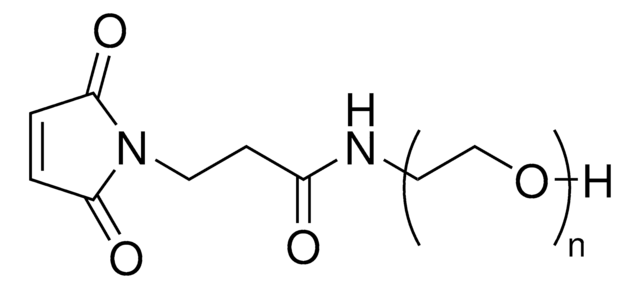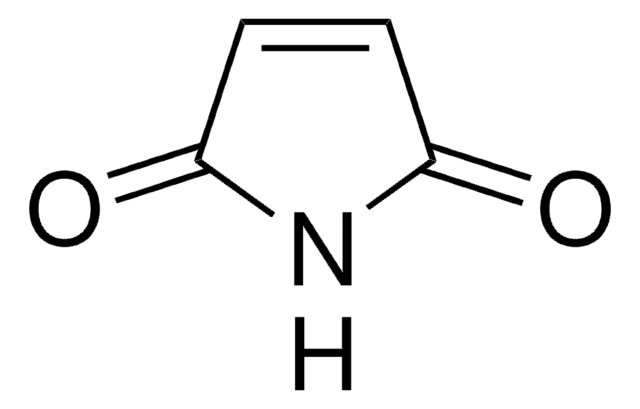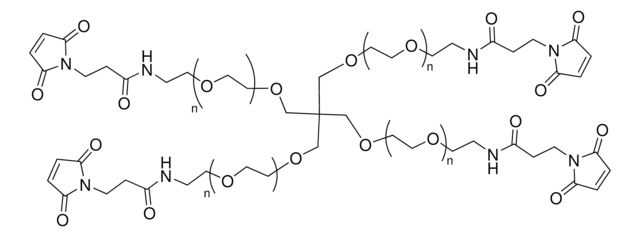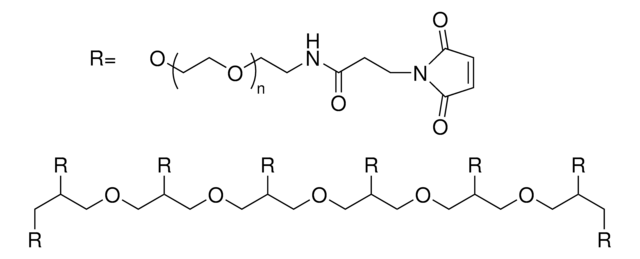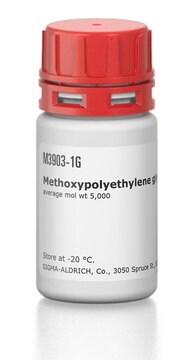63187
Methoxypolyethylene glycol maleimide
≥90% (NMR), 5,000
Sinónimos:
Polyethylene glycol, MeO-PEG-Mal, PEG-maleimide, mono-Methyl polyethylene glycol 2-maleimidoethyl ether
Iniciar sesiónpara Ver la Fijación de precios por contrato y de la organización
About This Item
Número de CAS:
Número MDL:
Código UNSPSC:
12162002
ID de la sustancia en PubChem:
NACRES:
NA.25
Productos recomendados
Nivel de calidad
Análisis
≥90% (NMR)
mol peso
PEG average Mn 5,000
Ω-final
maleimide
α-final
methoxy
temp. de almacenamiento
−20°C
¿Está buscando productos similares? Visita Guía de comparación de productos
Categorías relacionadas
Aplicación
Methoxypolyethylene glycol maleimide (MeO-PEG-Mal) is used as a protein pegylation reagent. PEGylation is the process of covalently attaching polyethylene glycol (PEG) polymer chains to other molecule such as proteins.
Producto relacionado
Referencia del producto
Descripción
Precios
Código de clase de almacenamiento
11 - Combustible Solids
Clase de riesgo para el agua (WGK)
WGK 3
Punto de inflamabilidad (°F)
Not applicable
Punto de inflamabilidad (°C)
Not applicable
Equipo de protección personal
Eyeshields, Gloves, type N95 (US)
Elija entre una de las versiones más recientes:
¿Ya tiene este producto?
Encuentre la documentación para los productos que ha comprado recientemente en la Biblioteca de documentos.
Los clientes también vieron
Jiankun Qie et al.
Drug metabolism letters, 1(3), 232-240 (2007-08-01)
Site-specific mono-PEGylations were performed in different conformational regions of Thymosin alpha 1 (T alpha 1) by introducing one cysteine residue into the chosen site and coupling with thiol-specific mPEG-MAL reagent. Results demonstrated that PEGylated sites and regions influenced the conformations
R J Goodson et al.
Bio/technology (Nature Publishing Company), 8(4), 343-346 (1990-04-01)
We have modified recombinant interleukin-2 (rIL-2) to facilitate site-directed covalent attachment of monomethoxy polyethylene glycol (PEG). The site chosen for modification and subsequent covalent attachment with PEG (PEGylation) was the single glycosylation position found in the native interleukin-2 (IL-2). The
K Ananda et al.
Analytical biochemistry, 374(2), 231-242 (2007-12-27)
The design of the extension arm-facilitated PEGylation (EAFP) of proteins takes advantage of the high selective and quantitative aspects of the thiol-maleimide reaction. However, the efficiency of EAFP with hemoglobin varied with the batches of maleimide-PEG. The low level of
Lidia Wrobel et al.
Scientific reports, 6, 27484-27484 (2016-06-07)
Disulfide bond formation is crucial for the biogenesis and structure of many proteins that are localized in the intermembrane space of mitochondria. The importance of disulfide bond formation within mitochondrial proteins was extended beyond soluble intermembrane space proteins. Tim22, a
Leah C Ray et al.
Nature chemical biology, 14(6), 538-541 (2018-05-18)
Polyprenol phosphate phosphoglycosyl transferases (PGTs) catalyze the first membrane-committed step in assembly of essential glycoconjugates. Currently there is no structure-function information to describe how monotopic PGTs coordinate the reaction between membrane-embedded and soluble substrates. We describe the structure and mode
Nuestro equipo de científicos tiene experiencia en todas las áreas de investigación: Ciencias de la vida, Ciencia de los materiales, Síntesis química, Cromatografía, Analítica y muchas otras.
Póngase en contacto con el Servicio técnico

